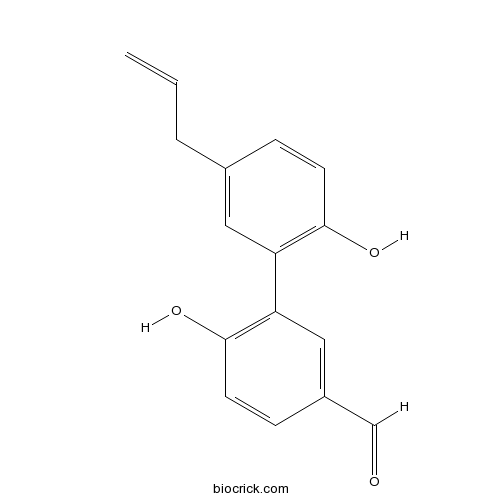Magnaldehyde DCAS# 93753-33-4 |

Quality Control & MSDS
3D structure
Package In Stock
Number of papers citing our products

| Cas No. | 93753-33-4 | SDF | Download SDF |
| PubChem ID | 5319189 | Appearance | Powder |
| Formula | C16H14O3 | M.Wt | 254.3 |
| Type of Compound | Lignans | Storage | Desiccate at -20°C |
| Solubility | Soluble in Chloroform,Dichloromethane,Ethyl Acetate,DMSO,Acetone,etc. | ||
| Chemical Name | 4-hydroxy-3-(2-hydroxy-5-prop-2-enylphenyl)benzaldehyde | ||
| SMILES | C=CCC1=CC(=C(C=C1)O)C2=C(C=CC(=C2)C=O)O | ||
| Standard InChIKey | KDWYPRNOEMXUNA-UHFFFAOYSA-N | ||
| Standard InChI | InChI=1S/C16H14O3/c1-2-3-11-4-6-15(18)13(8-11)14-9-12(10-17)5-7-16(14)19/h2,4-10,18-19H,1,3H2 | ||
| General tips | For obtaining a higher solubility , please warm the tube at 37 ℃ and shake it in the ultrasonic bath for a while.Stock solution can be stored below -20℃ for several months. We recommend that you prepare and use the solution on the same day. However, if the test schedule requires, the stock solutions can be prepared in advance, and the stock solution must be sealed and stored below -20℃. In general, the stock solution can be kept for several months. Before use, we recommend that you leave the vial at room temperature for at least an hour before opening it. |
||
| About Packaging | 1. The packaging of the product may be reversed during transportation, cause the high purity compounds to adhere to the neck or cap of the vial.Take the vail out of its packaging and shake gently until the compounds fall to the bottom of the vial. 2. For liquid products, please centrifuge at 500xg to gather the liquid to the bottom of the vial. 3. Try to avoid loss or contamination during the experiment. |
||
| Shipping Condition | Packaging according to customer requirements(5mg, 10mg, 20mg and more). Ship via FedEx, DHL, UPS, EMS or other couriers with RT, or blue ice upon request. | ||
| Description | Magnaldehyde D is a natural product from Magnolia officinalis. |
| In vitro | New biphenyl derivatives and anti-inflammatory constituents from the stem bark of Magnolia officinalis[Reference: WebLink]Planta Medica, 2011 , 77 (12):PG42.
The stem bark of Magnolia officinalis Rehd. et Wils. (Magnoliaceae) has been used as a traditional medicine for the treatment of gastrointestinal disorders, bronchitis, and emphysema, in China, Taiwan, Japan, and Korea [1]. Chemical studies have revealed a variety of neo-lignans and alkaloids as constituents of this plant. Many of these compounds exhibit central depressant effect, muscle relaxation, and antigastric ulcer, antibacterial, antiallergic, vasorelaxant, and neurotrophic activities. |
| Structure Identification | Magn Reson Chem. 2008 May;46(5):497-500.1H and 13C NMR assignments for two lignans from the heartwood of Streblus asper.[Pubmed: 18297743 ]
|

Magnaldehyde D Dilution Calculator

Magnaldehyde D Molarity Calculator
| 1 mg | 5 mg | 10 mg | 20 mg | 25 mg | |
| 1 mM | 3.9324 mL | 19.6618 mL | 39.3236 mL | 78.6473 mL | 98.3091 mL |
| 5 mM | 0.7865 mL | 3.9324 mL | 7.8647 mL | 15.7295 mL | 19.6618 mL |
| 10 mM | 0.3932 mL | 1.9662 mL | 3.9324 mL | 7.8647 mL | 9.8309 mL |
| 50 mM | 0.0786 mL | 0.3932 mL | 0.7865 mL | 1.5729 mL | 1.9662 mL |
| 100 mM | 0.0393 mL | 0.1966 mL | 0.3932 mL | 0.7865 mL | 0.9831 mL |
| * Note: If you are in the process of experiment, it's necessary to make the dilution ratios of the samples. The dilution data above is only for reference. Normally, it's can get a better solubility within lower of Concentrations. | |||||

Calcutta University

University of Minnesota

University of Maryland School of Medicine

University of Illinois at Chicago

The Ohio State University

University of Zurich

Harvard University

Colorado State University

Auburn University

Yale University

Worcester Polytechnic Institute

Washington State University

Stanford University

University of Leipzig

Universidade da Beira Interior

The Institute of Cancer Research

Heidelberg University

University of Amsterdam

University of Auckland

TsingHua University

The University of Michigan

Miami University

DRURY University

Jilin University

Fudan University

Wuhan University

Sun Yat-sen University

Universite de Paris

Deemed University

Auckland University

The University of Tokyo

Korea University
- Pacritinib (SB1518)
Catalog No.:BCC4558
CAS No.:937272-79-2
- SB1317
Catalog No.:BCC1925
CAS No.:937270-47-8
- ARRY-380
Catalog No.:BCC3726
CAS No.:937265-83-3
- NSC 95397
Catalog No.:BCC7109
CAS No.:93718-83-3
- GSK690693
Catalog No.:BCC2483
CAS No.:937174-76-0
- Leuconolam
Catalog No.:BCN4482
CAS No.:93710-27-1
- TC-H 106
Catalog No.:BCC2426
CAS No.:937039-45-7
- Magnolignan C
Catalog No.:BCN4085
CAS No.:93697-42-8
- OSI-027
Catalog No.:BCC4603
CAS No.:936890-98-1
- Forsythoside E
Catalog No.:BCN2782
CAS No.:93675-88-8
- Rengyol
Catalog No.:BCN4481
CAS No.:93675-85-5
- Magnolignan A
Catalog No.:BCN4084
CAS No.:93673-81-5
- GRP (human)
Catalog No.:BCC5810
CAS No.:93755-85-2
- Jangomolide
Catalog No.:BCN4483
CAS No.:93767-25-0
- Neogambogic acid
Catalog No.:BCN2321
CAS No.:93772-31-7
- Neurodazine
Catalog No.:BCC7738
CAS No.:937807-66-4
- gamma-Secretase Modulators
Catalog No.:BCC1586
CAS No.:937812-80-1
- Roxatidine Acetate HCl
Catalog No.:BCC4534
CAS No.:93793-83-0
- 3-Prenyl-2,4,6-trihydroxybenzophenone
Catalog No.:BCN1303
CAS No.:93796-20-4
- 22-beta-Acetoxyglycyrrhizin
Catalog No.:BCN7904
CAS No.:938042-17-2
- ATPγS tetralithium salt
Catalog No.:BCC7855
CAS No.:93839-89-5
- KU-0063794
Catalog No.:BCC2484
CAS No.:938440-64-3
- Isochamaejasmine
Catalog No.:BCN3128
CAS No.:93859-63-3
- 9-Oxo-2,7-bisaboladien-15-oic acid
Catalog No.:BCN4484
CAS No.:93888-59-6
1H and 13C NMR assignments for two lignans from the heartwood of Streblus asper.[Pubmed:18297743]
Magn Reson Chem. 2008 May;46(5):497-500.
In our ongoing investigation of the bioactive constituents from plants, two new lignans, magnolignan A-2-O-beta-D-glucopyranoside and strebluslignanol were isolated from heartwood of Streblus asper, along with three known lignans, magnolignan A, magnolol, and Magnaldehyde D. 1D and 2D NMR experiments, including COSY, HMQC, and HMBC, and other spectroscopic methods, including UV, IR, and MS were used for the determination of the structures and NMR assignments. Primary bioassays showed that magnolignan A-2-O-beta-D-glucopyranoside and strebluslignanol have medium cytotoxic activity against HEp-2 and HepG2 cells, with IC(50) of 13.3 microM, 46.4 microM and 10.1 microM, 21.7 microM, respectively.


